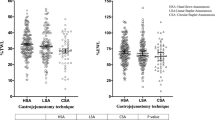Background: Gastric bypass may be facilitated by a stapled gastrojejunostomy.This study compared two different techniques for performing this critical anastomosis in open surgery. Methods: 67 consecutive patients were retrospectively studied for weight loss, hospital length of stay, anastomotic stricture, wound complication, and incisional hernia. 49 patients had a two layer handsutured gastrojejunostomy over a 34 Fr bougie via a laparotomy (sutured). 18 patients had a stapled gastrojejunostomy using the technique of Wittgrove and Clark via a laparotomy (stapled). All patients received prophylactic intravenous antibiotics preoperatively. Results: Initial BMI, % of excess weight lost at 6 weeks and 6 months, and hospital length of stay were not statistically different between the groups. However, the rate of wound complication and incisional hernia rate were significantly higher in the stapled group when compared to the sutured group (p<0.01). Conclusions: Based on these data we suggest that the technique of Wittgrove and Clark for performing the gastrojejunostomy should not be used in open gastric bypass as it results in increased rates of wound complication and incisional hernia.
Similar content being viewed by others
Author information
Authors and Affiliations
Rights and permissions
About this article
Cite this article
Madigan, J.D., Morales, D.L.S. & Bessler, M. A Technique of Stapled Gastrojejunostomy for Open Gastric Bypass Results in Increased Wound Complication-Rate. OBES SURG 10, 230–232 (2000). https://doi.org/10.1381/096089200321643340
Published:
Issue Date:
DOI: https://doi.org/10.1381/096089200321643340




